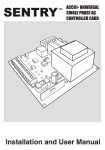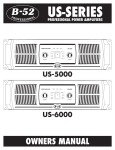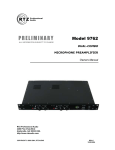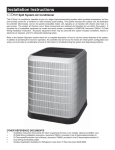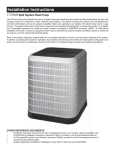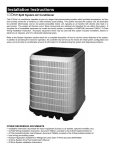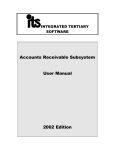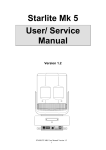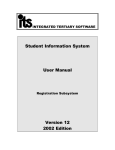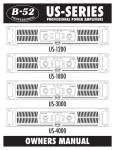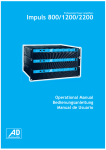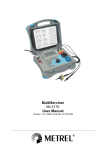Download Sentry DCC02 User manual
Transcript
SENTRY DCC02 Roll-up Garage Door Automation Installation and User Manual ENG Manufactured By Martin Electronics cc PO BOX 49284, ROSETTENVILE 2130 Republic of South Africa AFR Vervaardig Deur Martin Electronics cc Posbus 49284, ROSETTENVILE 2130 Republiek van Suid Afrika ESP Fabricado por Martin Electronics cc PO BOX 49284, ROSETTENVILE 2130 la República Surafricana DEU Hergestellt durch Martin Electronics cc PO-Kasten 49284, ROSETTENVILE 2130 Republik Südafrika POWERED BY Technical Support For technical queries relating to use/installation of this product! +27 11 433 4084 Table of Contents Warnings and Cautions for Use ................................................................. 5 Introduction .................................................................................................. Package Contents ............................................................................ Door Types and Considerations ....................................................... Door Checklist .................................................................................. 6 6 7 8 Required Equipment ................................................................................... 9 Component Details ..................................................................................... Head Unit ......................................................................................... Wall Console .................................................................................... Fitting Wall Console Cables ............................................................. 10 10 11 12 Fitment of Motor to Door ............................................................................ Motor orientation and motor wire sequence .................................... Fitment to standard platform doors .................................................. Fitment to other door types (KRAZI-DOOR, etc...) .......................... 14 15 16 22 Fitment of Wall Console .............................................................................. 25 System Commissioning .............................................................................. Connection Diagram For External Receiver ..................................... Connection Diagram For IR Beams ................................................. Connection Diagram for Remote Status LED .................................. Powering Up The System ................................................................ Setting Up Door Limits ..................................................................... Adding weight to very light doors ..................................................... 27 28 29 30 31 33 36 Programming Remote Controls ................................................................. 37 Selecting Remote Control Storage Slots .......................................... 38 Erasing all the remote controls ......................................................... 40 Advanced Features ..................................................................................... Activating and Deactivating auto-close ............................................ Adjusting the auto-close timer ......................................................... 41 42 43 Troubleshooting Guide .............................................................................. Limit Programming Troubleshooting ................................................. Operational and General Troubleshooting ........................................ Error codes and STATUS LED flashes ............................................. 44 44 45 47 Product Specification .................................................................................. 48 3 ENGLISH Company Profile ........................................................................................... 4 Company Profile The company manufactures remote controls, receivers, infrared beams and garage door automation products under the Sentry brand name. The company also manufactures products for OEM (Original Equipment Manufacturers) and custom markets and is deeply respected in this regard as it designs and manufactures not only its own products but specialised and custom products for specific customers and provides support for these products. MARTIN ELECTRONICS strives to give service and backup second to none. Technical staff, as well as our engineers are available to give answers to technical or installation problems. The equipment is installed countrywide and is available through a network of distributors in South Africa. Further information is available on our website www.martin-electronics.co.za © Martin Electronics cc 2009 Martin Electronics cc. reserves the right to make changes to the products described in this manual without notice and without obligation of Martin Electronics cc to notify any persons of any such revisions or changes. Additionally, Martin Electronics cc. makes no representations or warranties with respect to this manual. No part of this document may be copied, stored in a retrieval system or transmitted in any form or by any means electronic, mechanical, optical or photographic, without the express prior written consent of Martin Electronics cc. ENGLISH Martin Electronics is a respected and well-known manufacturer of RF remote controls and security products and has established itself as the leader in RF remote control for the past 20 years. WARNINGS AND CAUTIONS 1. Read all instructions and warnings carefully before installing the product 2. The product must only be installed by suitably qualified persons. 3. 10. Never short circuit any wiring to and from this equipment 11. The installer has a responsibility to explain to the owner/user how the system operates and how to deal with potential emergencies NEVER allow children to play with the door or that may arise during the scope and course its remote controls and keep children and pets of the product's application. The installer away from the door, especially when it is being must also pass on these instructions to the used. owner/user 4. Secure all remote controls and opening devices to prevent unauthorized access to the door. 5. Before attempting any work or maintenance on the product, disconnect the power and remove the batteries (if applicable) 6. All modifications not expressly approved by the manufacturer are forbidden. 7. Do not install the product in an explosive 14. Always ensure the manual override cord is atmosphere or in any location subject to heavy easily accessible at all times. moisture ingress. 15. Never short circuit the wiring between the Safety devices i.e. IR beam, must be fitted to wall console and the motorised head unit, of prevent death or injury by crushing due to this product. persons or pets being in the path of the door curtain. 8. 9. 12. The product is designed and manufactured only for the applications intended in this manual. Any other use renders the warranty null and void and neither the manufacturer or its distributors, affiliates, servants, etc. shall be held liable for any loss or damages whatsoever. 13. This product employs double insulation, and therefore does not require an earth conductor. Always keep objects, pets, and people away from the path of a moving door. Technical Support For technical queries relating to use/installation of this product! +27 11 433 4084 5 NOTICE REGARDING BATTERIES This product contains leadacid batteries, which may not be disposed of by way of regular household refuse. Please consult with your local authorities as to the safe procedure of disposal when the batteries are replaced or product disposed of. DO NOT DISASSEMBLE BATTERIES! CORROSIVE SULPHURIC ACID! ENGLISH PLEASE READ THE FOLLOWING WARNINGS AND CAUTIONS BEFORE INSTALLING OR USING THE PRODUCT. RISK OF ELECTRIC SHOCK AND/OR FIRE DO NOT TOUCH ANY COMPONENTS WHEN POWER IS APPLIED Introduction The product is designed to fit most roll-up garage doors that have plastic or metal spool wheels. It operates by applying a rotational force to one of these spool wheels which then in turn opens, or closes the door curtain as desired. The DCC02 system consists of two parts, one of which is the motorised portion, that drives the door, and fits inside the door curtain roll. This is known as the “head unit”. This part is controlled, electronically, from the wall console. The wall console contains the power source, and the remote control receiver and includes a courtesy light and a control button on the front cover. To keep wiring to a minimum, only a total of three wires are used between the units. This is made possible using a digital one-wire bus. The system provides limited battery back-up for mains failure situations. Alerts are provided for both mains failure and low battery conditions. The system integrates a learning remote control receiver which is compatible with SENTRY code hopping remote control transmitters. A maximum of 8 remote controls may be learnt into the system in total. Package Contents Power & Interconnect cables Masonry anchors (4 pcs 6x60) Motorised Head Unit U-bolt mounting kit Code Hopping Remote Control (2 pcs) 6 Wall Console ENGLISH The SENTRY DCC02 is a second-generation roll-up door automation product designed for domestic and light industrial applications. Door Types and Considerations Door Brands This product is designed to operate, primarily with common types of roll-up door makes and models found in the South African market. These include the WISPECO™ brand and the KRAZI-DOOR brand. Other types are suitable, provided they meet the criteria listed below. Door Type In general, the DCC02 is designed to operate the standard low-cost roll-up doors commonly used in domestic applications- doors which are fabricated from thin laminated steel or aluminium. It is not recommended for use with the 1970’s era heavy steel roll-up type doors, which are much heavier than the common roll-up door types. Door Sizing The DCC02 is designed to drive a single door by itself. For particularly wide doors, the product must be installed in the centre of the door, by fitting an additional adapter wheel. It is not possible to fit two motor head units to a single door. The height of the door is not a factor, therefore, standard height doors as well as “caravan doors” are suitable candidates for this product. Door Condition The condition, and quality of the installation of the door plays a MAJOR role in whether the installation of this product (or any other garage door automation product) will be successful or not. Common problems that cause this product to fail, either immediately, or after some time include: Doors that are not true- These are doors that are installed skew, leading to the formation of gaps at the bottom when the door is fully closed. The DCC02 does close the door completely to the floor but it was not designed to drive the door curtain into the floor to seal against flooding etc... Doors that are not balanced- These are doors that, although they appear to be light to move by hand, either suffer from tight spots during travel, or get stiff in cold weather. The DCC02 can compensate to a large degree, for cold stiffness but beyond this, will consistently go into over-current to protect the motor. Doors that are too light- A frequent problem is a door that is too light, causing the door to unravel at the top, when closing. In these cases, it is necessary to add weight to the bottom of the door, in the form of a steel bar or angle iron. Doors that are too light also cause the system to exhibit various symptoms. These symptoms include moving short distances, stopping shortly after opening, etc.. 7 ENGLISH IMPORTANT - PLEASE READ THIS SECTION CAREFULLY TO ENSURE THAT THE DOOR YOU INTEND TO AUTOMATE, MEETS THE REQUIREMENTS FOR SUCCESSFUL AND TROUBLE-FREE OPERATION! Door Types and Considerations ENGLISH Doors with bent take-up spools- These are doors with bent spools, that pull the head unit’s driving wheel proportionately skew. The product suffers damage and exhibits all kinds of fault conditions, most commonly that of moving short distances. Door Condition Checklist ý Uneven Floor / Door Mounted Skew ý Unbalanced door (tends to open by itself due to over-tensioned springs) Door Curtain ü Door lands flat on floor and doesn’t recoil ü Door equally easy to lift, or to pull down ý ü Internal wheel (plastic or metal) Tube Bent, warped, or skew spool wheels This causes damage to the product and is very common on badly installed doors and/or very cheap doors!! 8 The start of the door curtain must be affixed at the end, to the door spools using a tek screw. This helps prevent problems and also secures the door better against intrusion Required Equipment for Installation Small Side Cutter Multimeter Tek Screws Length of Angled Steel Masonry Drill Bit (6 ~ 6.5mm) Length of Rectangular steel bar (To fabricate a baseplate for KRAZI DOORS) Drill with impact setting HSS Drill Bits (6 ~ 10mm) Impact Drill Spanner set (17 ~ 21) 9 ENGLISH Philips screwdriver & Flat screwdriver Component Detail - Head Unit 2 5 6 3 4 7 9 8 Shown with cover removed 6. Manual Override lanyard guide 7. Optical Pick-up 8. Optical encoder gear 9. Power and signaling connector 1. DC Motor 2. Plastic unit housing 3. Motor wires (green & brown) 4. Head unit controller PCB 5. Manual Override Engage/disengage lever THE POWER AND SIGNALING CABLE (3 CORE) CAN ONLY GO INTO THE PCB IN ONE ORIENTATION WITH THE RELEASE TAB FACING DOWNWARDS. FORCING IT IN ANY OTHER WAY WILL CAUSE DAMAGE TO THE PRODUCT AND MAY LEAD TO BURNS AND/OR FIRE FROM THE RESULTING SHORT CIRCUIT. ü CORRECT ý WRONG 10 ENGLISH 1 Component Detail - Wall Console ENGLISH 7 1 8 9 10 2 15 11 3 12 13 14 4 5 6 Shown with cover removed 8. STATUS LED indicator 9. Auxillary supply fuse (1 AMP) 10. Main fuse (5 AMP) 11. TRIGGER button 12. POWER GOOD LED indicator 13. Buzzer 14. Toroidial transformer 15. LED lamp 1. Lead-acid battery (12V 1.3Ah x 2) 2. Battery interconnects 3. Remote receiver antenna lead (BROWN) 4. SET button 5. LEARN button 6. Transformer wiring loom (6 cores terminated onto Molex connector) 7. Auxillary connection terminals The product is supplied without the power and interconnecting leads fitted to the wall console. The leads are to be plugged into the wall console PC board as shown in the next section. TAKE CARE WHEN REMOVING OR REPLACING THE COVER OF THE WALL CONSOLE, OR DURING TRANSPORTATION AS DAMAGE COULD RESULT TO THE LED LAMP 15 11 Wall Console - Fitting the cables ENGLISH 2 pin header (AC MAINS) FUSE SUPPLIED MAINS LEAD WITH PLUG (Plug fitted varies according to region and local mains voltage) Locate the two pin header on the underside of the wall console PCB as shown above. Plug the two pin receptacle on the one end of the mains lead, as shown, into the receptacle. The moulded grommet, on the cable is designed to slot into a mating receptacle in the base of the wall console as shown above. 12 Wall Console - Fitting the cables ENGLISH SUPPLIED INTERCONNECT CABLE ü ý Locate the three pin header on the underside of the wall console PCB as shown above. Plug either end of the interconnecting cable into the receptacle. The moulded grommet, on the cable is designed to slot into a mating receptacle in the base of the wall console as shown above. 13 Motor Head Unit Installation In general, two types of door design exist, the first type is the “Wispeco” type door where the door pole is mounted on a platform. The second, more common door type are those doors consisting of a retaining plate. Both types will be covered in the following sections. In all cases, you will need to loosen one end of the door, and re-balancing will inevitably required once the motor is fitted. The motor may be mounted either side, where space permits, however pay special attention to the motor polarity wires as this will need to be changed according to which side the motor is installed. Determining which side of the door is the left and right Left Hand Side Right Hand Side Viewed from inside garage From inside the garage, i.e. where the roll is situated, looking at the door as shown, the left hand side is to your left, the right hand side is to your right. The motor is factory shipped by default for a left hand side install. If you would like to install the motor on the right hand side, it is necessary to swap the motor wires on the motor PCB as shown on the next page. 14 ENGLISH The following sections detail how to install the motor head onto the door. Please pay special attention to the various aspects of installation as failure to do so will lead to product failure and/or malfunction. Motor Head Unit Installation ENGLISH Factory Shipped Configuration Left Hand Side Install GREEN BROWN 8 Right Hand Side Install 8 GREEN BROWN 15 Motor Head Unit Installation Most doors, predominantly the WISPECO™ doors are platform mount doors i.e. the tube rests on platforms to which it is affixed with u-bolts. Many other doors have different types of fixing systems, but the principle remains the same. 1 Loosen and remove the existing u-bolt completely. 2 Lift tube off from the platform and away from it and lower downwards as shown. Support using a trestle or scaffold, ensure enough space to fit motor. Note: Other types of doors do not have platforms but side panel brackets, the procedure is the same, lift the tube off the bracket and support it as shown. 16 ENGLISH Once you have determined where you would like to install the motor, and have changed the motor wires accordingly (if necessary) the next step required is to loosen the desired end of the door. The tube is moved away from the door support so that the motor can be slipped onto the tube. Motor Head Unit Installation With the motor gearbox disengaged, push the motor onto the tube until it is supported on the tube. Do not yet push it against the spool wheel. 4 With the motor head unit on the edge of the steel tube, align the two drive hooks on the driving wheel, so that it will brace against one of the spokes of the spool wheel. 17 ENGLISH 3 Motor Head Unit Installation ENGLISH 5 With the two drive hooks aligned as shown in the previous step, gently press the motor and the spool wheel together as shown. The motor must fit snugly against the spool wheel. Lift the door tube back onto the platform, the stem of the motor unit resting on the platform. WARNING: if it does not fit, do not force it, instead acquire an adaptor wheel and fit it to the door, or replace the spool wheel with a SENTRY adaptor wheel. The drive hooks are critical items and must not be damaged in any way due to being forced to fit, or by being machined. This could lead to product failure, resulting in potential injury, and damage to property. Machining of the drive hooks and/or damage to them will render the warranty null and void! An acceptable alternative approach, is to machine material off the spoke to allow enough clearance for the drive hooks. Please be aware that there is a limit to how much this can be done, and in any case, a retrofit of an adaptor wheel is always recommended. 18 Motor Head Unit Installation ENGLISH 6 Looking at the opposite side of the motor, that is, from the driving wheel side, ensure that both drive hooks fit snugly as shown in the above diagram. The maximum amount of clearance between the surfaces of the spool wheel and the drive hooks is approximately 1.5mm. Too much free play on either or both drive hooks, will cause product malfunction (false collisions and stopping short) 7 Reposition the tube, as shown here, on the platform, ensuring it is in the same position when you removed it originally. Attach the supplied release lanyard to the release pawl and route the nylon lanyard as shown in this diagram. Caution: ensure the release lanyard is clear of the door curtain edge at all times. Route the cord in a manner that is kept clear of the door curtain. Release Lanyard 19 Motor Head Unit Installation ENGLISH Tightening the motor and tube assembly For platform type (WISPECO™) doors, replace the original u-bolt. Inspect the washers and nuts and replace if needed For other types of doors, you will need to use the supplied u-bolt, cut and drill a baseplate, and install as shown in the following sections from page 22 onwards. 8 Reinstall and tighten the original u-bolt as shown alongside. Be sure to tighten the u-bolt nuts sufficiently so that the stem of the motor unit is clamped securely, and cannot slip sideways off the platform. It may be necessary to fit washers beneath the nuts to achieve optimal tightness. Note: In some instances it will be necessary to fit the cover before tightening the motor as it will be difficult to get the cover on afterwards. 9 Connect the free end of the supplied interconnect cable to the receptacle on the PCB as shown. Route the cable along the platform edge to keep it away from the door curtain edge. Caution: Ensure there is enough cable slack in the portion that enters the PC board compartment so that fitment of the cover is not problematic! Refer to Page 10 for correct plug orientation! 20 Motor Head Unit Installation When fitting the cover, route the motor wires and the interconnecting cable through the slots in the cover as shown. The cover is a press-fit, it is not affixed with screws. Once the motor is attached to the door, the u-bolt may be fastened. With the motor disengaged, the door needs to be checked for balance, and if necessary, adjustments made. Additionally if the door is light, it will be necessary to add weight at the bottom, using a length of angled steel as listed under “Required Equipment” 21 ENGLISH 10 Motor Head Unit Installation For KRAZI DOOR (and other similar doors) it is necessary to fabricate a steel baseplate and use it in conjunction with the supplied u-bolt. This configuration is the only acceptable one - not doing this exactly as shown will lead to product failure which is not covered by warranty! Using steel bar, as indicated in "Required Tools and Equipment", fabricate a steel baseplate with the following dimensions: DIA TO SUIT TEK SCREW USED 12.5mm 25mm 70mm DIA = 10mm 48.5mm 97mm PLATE THICKNESS = 5~7mm Notes: Ensure all holes are drilled correctly- if they are too small it will be difficult to install the u-bolt assembly with this baseplate. Use of material thinner than 5mm is not recommended as it will distort and fatigue due to the forces the door exerts on this part. 22 ENGLISH Tightening the motor unit on a door with side plates (KRAZI-DOOR, etc..) Motor Head Unit Installation ENGLISH The above figure shows how the u-bolt fits over the tube, and restrains the motor unit to the tube, without reliance on a platform or interfering with the side plates. The motor can be mounted, on these kinds of doors, in any position. Generally the position is chosen to best permit the routing of the power cable and the release lanyard. On the next page, the sequence to assemble the u-bolt is shown. 23 Motor Head Unit Installation ENGLISH 1 2 4 3 5 Step 1 - Fit the u-bolt over the motor unit stem as shown Step 2 - Fasten the u-bolt to the tube by means of a tek screw (a hole will now be made in the tube, locking the u-bolt securely in place) Step 3 - Fit the baseplate onto the ends of the u-bolt Step 4 - Fit the washers and the nuts Step 5 - Tighten the nuts, reasonably tight. DO NOT OVERTIGHTEN Once the motor is attached to the door, the tube may be reinserted into the bracket and the steel retaining pin replaced. With the motor disengaged, the door needs to be checked for balance, and if necessary, adjustments made. Additionally if the door is light, it will be necessary to add weight at the bottom, using a length of angled steel as listed under “Required Equipment” 24 Wall Console Installation Mounting Distance From Motor Head Unit In most cases, the length of the supplied interconnect cable is the general rule of thumb. However in some instances it may not be possible to mount the wall console this close to the motor. The interconnect cable may be lengthened, but by an additional 2 metres only. This is achieved using three core cabtyre (1,25mm² or greater). Mounting Template To assist with marking off hole locations on the surface where the wall console is to be mounted, a template is provided, which is located in the centre of this manual and may be pulled out. Mounting Considerations The wall console should be mounted in a location that is dry and not subject to moisture. It should also preferably be mounted at a convenient height, but not too low as this would affect remote control reception. Mounting on or near very large metal structures should be avoided. 15 4 5 Wall console base with arrows showing keyhole style mounting holes 25 ENGLISH The wall console is designed to be affixed to any surface using a variety of screws. Four keyhole style mounting holes are provided in the base of the wall console for easy mounting on a variety of surfaces. In most cases the unit will be affixed to a wall, and the four supplied masonry wall anchors provided, should be used. Wall Console Installation For typical masonry (brick wall) mounting, it is recommended to install the nail in anchors as shown. The plastic sleeves are inserted into the wall first after being drilled with the hammer drill. 2 Once the sleeves are inserted into the wall, the wall console may be mounted onto the wall. Be careful when inserting the steel screws, do NOT hammer them in, use a screwdriver (or cordless screwdriver) to gently screw them into the wall. Note how screw is inserted into keyhole mounting hole Once the wall console is mounted, ensure that is secure and cannot be pulled from the wall or mounting surface. 26 ENGLISH 1 System Commissioning This section explains the steps to be followed to commission the DCC02 post fitment and installation on the door. Commissioning involves powering the system for the first time, programming the limits, as well as additional electrical connections as may be required for some applications. Standard Installation In most cases, the DCC02 will be installed in a stock-standard configuration without any ancillary systems attached (beams, status indication extension, external receiver). If this is the case, you can proceed directly to the section “System PowerUp” Enhanced Installation The DCC02 supports the use of safety beams to prevent injury to persons who are likely to come into the path of a closing door. The use of a beam also offers peace of mind when a door is likely to be triggered whilst a vehicle is moved in or out of the garage. The use of a beam is MANDATORY when the auto-close feature is enabled! Failure to install a beam when auto-close is enabled can lead to property damage and/or injury from a door that starts without warning. In addition to beams, the DCC02 also supports the use of other remote control receivers, as may be necessary in some installations (particularly when a compatibility issue arises and the existing systems cannot be migrated to a SENTRY remote control product). Enhanced Installation Detail The following sections explain electrical and other details pertaining to enhanced installations Using an external receiver with the DCC02 The DCC02 accommodates most any type of external receiver and provides a convenient power source for the receiver, which should be mounted externally to the wall console. The wall console provides a 24V DC supply for ancillary items, therefore it is important to ensure that the receiver you intend using, can operate from 24 volts. Most third-party receivers are able to operate from a 24 volt supply. The receiver you intend to use, must have a normally-open potential free relay contact. Receivers that output a “logic level” are not suitable. 27 ENGLISH System Commissioning Procedure System Commissioning - External Rcvr ENGLISH Connection Diagram for External Receiver External Receiver Close up of wall console Ancillary terminals RED BLK GRN GRN BLK Cable: 4 core “comms” cable RED Note that the common of the relay contact on the receiver is connected to the negative terminal of the receiver, therefore only three wires are needed. Wall Console Terminal Description Trigger TRG Common COM 24V Positive Supply B+ Receiver Terminal N/O - & COM + or +12/24 Ensure that the receiver you intend to use, can operate from a 24 volt DC supply. 28 System Commissioning - Beams ENGLISH Connection Diagram for Infra-Red Safety Beams Receiver SENTRY IR BEAM Transmitter 24 12 0 NC RED BLK BLU NO CO M Close up of wall console Ancillary terminals RED BLK BLU BLK RED Cable: 4 core “comms” cable Colour code: As per suggested WALL CONSOLE TERMINALS TRG BM COM B+ LED RED 24 12 BLK BEAM TX 0 24 12 0 BLU NC NO COM 29 BEAM RX System Commissioning - Remote LED A remote STATUS LED allows the user to know the status of the garage door (open, closed or trouble) from a remote location within his/her residence. A standard 5mm RED LED is required for this feature (not supplied). No series resistor is required and the line has protection against lightning. Close up of wall console Ancillary terminals RED A BLK C GRN BLK RED Long Lead (ANODE) Short Lead (CATHODE) Flat notch (DENOTES CATHODE) Take care when mounting the LED on a panel or when bending the leads apart to solder the wires to them. The maximum length of cable run is 15 -20 metres. Use thicker crosssection solid copper wire for longer runs otherwise LED brightness will be imparied! 30 ENGLISH Connection Diagram for installing a remote status LED System Commissioning - Powering Up Once installation is complete, and, if applicable, the connections to beams and/or an external receiver has been made, the system can be powered up by connecting the batteries first (linking the terminal as shown below) and then by plugging in the mains lead into an outlet and turning it on. Powering Up 1. Connect the batteries by connecting the loose terminal, to the battery as shown 2. Plug the mains lead into a wall outlet and turn it on. 1 2 MAIN FUSE (F2) POWER GOOD LED On the drawing opposite, note the location of the main fuse F2. This is the first point to check when troubleshooting. Also see Page 32 for a detailed description When power is applied, the system will give two high frequency beeps, signalling that the system has powered up. The system signals various conditions using audio-visual indications. The POWER GOOD LED lights when power is present. e high frequency beep, generally indicating confirmation or a change in status. e# low frequency beep, generally indicating error conditions or trouble. 31 ENGLISH Powering Up the System System Commissioning - Powering Up If the system has powered up correctly, there will be no further beeps. However, if there is a problem, the system will emit error beeps and flash an error code on the STATUS LED. These issues MUST be resolved before the system can enter limit programming. Two possible situations could exist post power-up: e# x 2 - two low-frequency beeps! This indicates MAINS FAILURE x 4 - four low-frequency beeps! This indicates COMMUNICATIONS FAILURE! These system errors can be resolved by working through the “Troubleshooting” section on page 44. However the following quick checks can be performed: MAINS FAILURE: Check inline fuse on the supplied mains lead. If blown, replace with a 1 AMP SLOW BLOW glass cartridge fuse. COMMUNICATIONS FAILURE: Check if there is power on the head unit by removing the cover and seeing if the STATUS LED on the PC board flashes (see below), if not, measure the two outer terminals of the interconnecting cable with a multi-meter. The reading should be 25-29V DC. If no voltage is present, check the main fuse on the wall console designated F2. Replace if blown. If this fuse continues to blow, check the interconnect lead orientation, and especially the wiring if you have extended the lead. When F2 blows on the wall console, it is generally indicative of a short circuit on the DC supply. Replacing this fuse with a fuse of higher rating can cause a fire, serious burns and severe product damage, which is not covered by warranty. If in doubt, please call Technical Support. STATUS Indicator This STATUS indicator flashes continuously during normal operation, indicating that communication is taking place between the wall console and the motor unit 32 ENGLISH Powering Up (cont..) System Commissioning - Limits Before the garage door operator can be used, the door limits have to be programmed. This is an automated process, that involves little user input. Assuming the system has powered up correctly (no beeping) the limits can then be programmed by following the procedure in the following sections. In the factory shipped state, the system will only accept a Limit Setup command, all triggers are ignored until the door is set up correctly. This is not a fault, it is for your safety. To invoke Limit Programming 1. Close the roll-up door completely and ensure that the door seats properly on the floor. Ensure the door is ENGAGED. If you cannot lift the door, it is engaged, if not, pull the mechanical release cord until the door is locked. 2. Remove the wall console cover, and press and HOLD SET, until a beep is heard. The door will begin to open slowly. When running the Limit Programming utility, please ensure that the batteries have had sufficient time to charge (usually 3-4 hours from the factory) and that the batteries are connected. Performing Limit Programming without batteries connected is not permitted, and will lead to product failure. Press and Hold “SET” e Single Beep 33 ENGLISH Limit Programming System Commissioning - Limits The door will open slowly until the end-stop is encountered. When the endstop is encountered, the door will stop for a few seconds, then close at full speed, then stop. It will wait for a few seconds and then open fully at full speed. This is done in order to measure various parameters needed to set the collision sensitivity automatically, amongst other parameters. 1 Door opens slowly in the first stage of limit programming 2 The door will open slowly until the end-stop is encountered as shown. The endstops MUST be secure or the setup will fail. The endstops must also be straight and equally spaced on both sides to prevent the formation of gaps when the door is closed. Safety inputs (BEAM) and the trigger input are unresponsive during this procedure. Ensure no people, pets or property can land in the path of the moving door curtain. Door homes against metal endstop, this registers the limit. The motor then stops. 34 ENGLISH Limit Programming (cont) System Commissioning - Limits Door closes at full rated speed 4 The door will then open at the full rated speed and will stop at the end limit. Instead of homing against the end stop, a small gap will be evident between the door curtain edge and the endstop. This gap is computed by the system and varies from door to door. On very light doors there may be no gap at all, which is a sign that weight may need to be added. Door opens at full rated speed Once the door is fully opened, the limit setup will be complete. The wall console will beep twice, indicating successful limit programming. From this point on, the trigger button on the wall console, as well as the trigger input and safety beam input will be active. If, for some reason, the Limit Programming routine fails, the system will issue one single error beep and exit the limit programming routine. The system will then be in standby and will await another Limit Programming command. Refer to the troubleshooting section in this manual for possible solutions. 35 ENGLISH 3 Once the upper limit has been registered (stall against endstop) the door will close automatically at full speed. The door will slow down and stop fully closed. System Commissioning - Limits In general, when the roll-up door is very light, a number of symptoms may become apparent and cause temporary malfunctions of the product. These include stopping after moving short distances and not closing completely. In these cases, it is necessary to add weight to the bottom edge of the door curtain. The recommended way of adding weight is to affix a length of angled steel to the bottom edge of the door curtain as shown: Tek Screws Angled Steel Aluminum door edge The angled steel is attached directly to the aluminium edging of the door curtain with tek screws. Depending on the door type, other screws may be used. The steel is mounted on the inside of the door i.e. the side facing the inside of the garage. Once weight is added to the door, it may need adjustment. Ensure that the door is consistently easily lift-able once the weight is added. Use short screws, long ones may damage the rubber at the bottom of the door curtain. 36 ENGLISH Adding weight to very light doors System Commissioning - Programming Remotes The DCC02 is supplied with two four code-hopping remote controls which are intended for use with this product. The user can purchase additional remote controls and add them to the system up to a maximum of 16 remote controls into the memory of the built-in receiver at any given time. The system is shipped from the factory in a blank state, i.e. there are no remote controls learnt into the system. When learning remote controls, always operate the remote control at least 5 metres away from the wall console. Ensure that no other remote controls are operating in the near vicinity during this procedure as these remotes will be inadvertently learnt into the system. Learning a new remote into the system The DCC02 stores remote controls in what is called “slots”. Each remote control added to the system occupies a slot. A slot can generally only be overwritten or all slots mass erased. The most common mistake is to not select an unallocated slot when adding remotes to the system, which leads to the previous remotes learnt, being overwritten. The following explains how to program the remotes correctly into the system. 1 2 Press and release “LRN” e Single Beep 37 ENGLISH Programming Remote Controls into the system System Commissioning - Programming Remotes When in learn mode, the current slot selected is slot 1. To advance to the next slot, press LRN again to advance the slot number to slot 2. When a slot is selected, and unoccupied, the STATUS LED will be off, if a slot is occupied, the STATUS LED will be lit. This aids the user in avoiding active memory locations when adding new remote controls. LRN E Press and release LRN button LEARN MODE e x1 Slot 1 (Default) Slot 2 LRN e x1 E E Press and release LRN button LRN e x1 If no remote control is learnt into the system within 15 seconds, the system will return to normal operation, which is signaled with an error beep! Press and release LRN button If you inadvertently enter learn mode, simply allow the system to time-out and return to normal operation after the 15 second delay. If the product is used in the vicinity where many other remote controls are active, we recommend that the slot 1 be skipped. This will help prevent unintended learning of transmitters in the area. LRN Slot 15 Slot 16 (Last) 38 e x1 E Press and release LRN button ENGLISH As shown on the previous page, pressing and releasing the LRN button, switches the system into remote programming mode. A single beep indicates this. System Commissioning - Programming Remotes Upon successful learning, the wall console will issue two confirmation beeps and exit learn mode. To add more remotes, you will need to enter learn mode again and select the desired slot. 3 4 Always operate the remote control at least 5m away from the wall console when learning it into the system e Double Beep Once a remote control (and the chosen button) is learnt into the system successfully, pressing the learnt button on the remote control will open and close the door. Learning another remote control into a given slot will erase the previously learnt remote control (and button). Be careful! 39 ENGLISH Once the desired slot has been selected, operate the desired button on the remote control, to program it into the system. System Commissioning - Erasing Remotes To erase all the remote controls in the system, in cases where there has been a security breach or to reset the remote control storage to factory defaults, the following procedure will erase all the remote controls. Performing this operation will render all remote controls useless. This could lead to you being locked into your own garage! Proceed with this step only if you have access to the trigger button or the manual override. ~5 secs LRN E Press and hold LRN button e x1 STATUS LED Flashes Rapidly e x2 LRN E Release LRN button ~1 sec e x1 All remotes erased Returns to normal operation Once all remotes are erased, any existing remotes will have to be reprogrammed into the system from scratch! 40 ENGLISH Erasing all the remote controls in the system Advanced Features The DCC02 is equipped with a programmable auto-close timer, which is accessible via a menu termed the “advanced features menu”. The structure of this menu is shown as follows: SET E ADVANCED FEATURES MENU Press and release SET button e x1 STATUS LED: AUTO-CLOSE OPTION MENU ITEM 1 SHORT FLASH / 2 sec SET E Press and release SET button e x1 STATUS LED: AUTO-CLOSE TIMER MENU ITEM 2 SHORT FLASH / 2 sec Trigger Exits Menu TRIGGER E Normal Operation Press and release TRIGGER button e x1 When the advanced features menu is engaged, all triggers are ignored. It is not possible to invoke the menus if the door is in motion. 41 ENGLISH Advanced Features Advanced Features - Auto-Close Selection The auto-close function can be enabled/disabled as follows. Please be aware that when auto-close is enabled, there MUST be a safety beam present. Enabling Auto-close Feature STATUS LED: 1. Press SET 2. Press LRN 3. Press SET 4. Press TRIGGER AUTO-CLOSE OPTION MENU ITEM 1 SHORT FLASH / 2 sec Disabling Auto-close Feature 1. Press SET 2. Press LRN 3. Press LRN 4. Press TRIGGER LRN E Press and release LRN button e x1 STATUS LED: AC ON AUTO-CLOSE OPTION SUB-MENU AC OFF SET E LRN Press and release SET button e AUTO-CLOSE ON TO MAIN MENU (ADVANCED FEATURES) 42 x2 E Press and release LRN button e x2 AUTO-CLOSE OFF ENGLISH Auto-Close Function Enable/Disable Advanced Features - Auto-Close Timer When enabled, the auto-close timer can be adjusted for time-out periods between 10 seconds and 250 seconds. Adjustment below or above this range will result in an error indication. The factory default is 30 seconds. STATUS LED: AUTO-CLOSE TIMER MENU ITEM 2 SHORT FLASH / 2 sec LRN E Press and release LRN button Return to Main Menu (Advanced Features) AUTO-CLOSE TIMER SUB-MENU Increase Time by 10 seconds SET E Press and release SET button Decrease Time by 10 seconds LRN TRIGGER E e x1 Press and release TRIGGER button e x2 E Press and release LRN button Save Changes and Exit 43 e x1 e x1 ENGLISH Auto-Close Timer Adjustment Troubleshooting Guide The following is a thorough guide to solving problems that occur with the DCC02. It is split into two sections, one for diagnosing troubles during limit programming, the other for diagnosing problems during normal running. These are by no means exhaustive lists of all the possible combinations of problems that occur, but these guides do cover over 90 percent of the problems that our customers experience with this product and how to best resolve them. Always work through these guides first when solving problems, before calling technical support. This will allow us to provide the best possible support to every single customer. Where a particular problem is not described in these guides, you are encouraged to call us or e-mail us for prompt resolution to your query. We also publish a FAQ on our website, be sure to have a look at that as well for any latebreaking issues that have come to light since publication of this manual. SECTION A: LIMIT SET-UP TROUBLESHOOTING Problem Likely Cause(s) Possible solution(s) Cannot set the door up, system constantly beeps four times when power is applied. • Power Problem • Problem with interconnecting cable • Main fuse (F2) in console blown or fatigued. • Check fuse F2 • Check the wiring, especially if you lengthened the cable. Check for voltage across the two outer terminals of the interconnecting cable. If none present, replace F2 in the wall console. The door moves a short distance, then stops with an error beep when attempt is made to program the limits. • Door not balanced • Spool wheel bent • Dirt/foreign matter on encoder wheel. • Check the door, if there’s a tight spot during upwards travel, you will need to fix it. • A bent spool wheel pulls the driving wheel away from the motor chassis, leading to it coming off the chassis altogether and the encoder no longer rotates. Replace spool wheel or fit an adaptor wheel available from the place where you purchased this product. • Sometimes, dust and dirt from the installation gets onto the encoder wheel, blocking the holes and the system can no longer measure distance traveled. Ensure the area is clean and free of dust/foreign matter. 6 44 ENGLISH Troubleshooting Guide Troubleshooting Guide Problem The door moves slowly, reaches the endstop and then fails to stop with a loud “clack clack clack” noise. Likely Cause(s) • Door too light • Endstops not secure enough. Possible solution(s) • Add weight to door as shown on page 36. • Make sure the endstops are secure, if not you may need to retrofit additional endstops. SECTION B: GENERAL OPERATING MODE TROUBLESHOOTING Problem Likely Cause(s) Possible solution(s) Wall console constantly beeps twice • No mains present • Mains fuse blown • Check plug socket, and circuit breaker. • Replace the fuse (1A Time lag glass cartridge). It is an inline fuse fitted on the mains lead. Wall console constantly beeps four times • MAIN FUSE (F2) in wall console blown. • Interconnection lead problem. • Check the fuse (F2) in the wall console and replace if blown or faulty. If the fuse repeatedly blows, please contact technical support. • Check the interconnection lead, make sure it is plugged in securely at both ends. The lead can be checked by measuring the outer terminals for voltage (between 23 and 30 volts DC, depending on mains voltage) Door opens a short distance, then stops. Cannot open door greater than this distance. • Encoder problem • Disengage the door, and open and close fully, and ensure that the gear turns all the time when the door is closed and opened fully. If it does not, the spool wheel has likely damaged the drive wheel and pulled it off the chassis. This occurs due to incorrect installation! • Encoder dirty, ensure it is clean and free of debris. Sometimes insects and other objects get into the encoder. 45 ENGLISH SECTION A: LIMIT SET-UP TROUBLESHOOTING (cont) Troubleshooting Guide Problem Likely Cause(s) Possible solution(s) Cannot enter limit programming • Door not closed fully • Ensure the door has been closed fully, if not the cause, power cycle the system and then try again. Door moves short distances when opened and repeated triggers result in further normal operation sometimes after several attempts • Cold Start issue (pre Jan 2009) • Units manufactured prior to January 2009 had a software issue, this has been resolved (see website for further details) Door closes by itself • Auto-close inadvertently engaged • Disengage auto-close mode as per page 42 Door moves consistently short distances, will not open further than 10 cm. • Encoder problem • Bad installation • Door very light • Check encoder • If installation not carried out as per this manual, that is the likely reason why. • Add weight to the door. Door doesn’t close properly, there is always a gap at the bottom • Bad insallation • Door not straight • Door very light • Rectify any installation problems first. • If the door is not straight it is most likely impossible to rectify as it involves removal of the entire door. Add self-adhesive foam rubber to the bottom edge of the door to resolve. • Add weight to the door. Each new remote learnt into the system, erases the previous one I just learnt in. • Procedure Incorrect • Carefully follow the procedure as shown on page 38. Note that this product learns slightly differently compared to other SENTRY products No auxillary power/ beams and/or external receiver connected does not work. • Blown AUX FUSE (F1) in wall console. • Check (and replace) this fuse. Frequently, the door opens slowly when opened and then runs as normal • Play on the door • There is likely free play on the door somewhere. The DCC02 is sensing movement on the encoder wheel when the door is stationary. The door opens by itself at random times • Another transmitter, elsewhere was inadvertently learned into the system. • Perform complete erasure of all stored remotes and learn them in again. 46 ENGLISH SECTION B: GENERAL OPERATING MODE TROUBLESHOOTING Troubleshooting Guide - Error and Status Codes ENGLISH NORMAL OPERATION STATUS LED OFF = DOOR CLOSED SLOW FLASH = DOOR OPENING ON = DOOR FULLY/PARTIALLY OPEN OR PARTIALLY CLOSED FAST FLASH = DOOR CLOSING ERROR CONDITION (ONLY INDICATED WHEN DOOR IS STATIONARY) MAINS FAILURE 2 SHORT FLASHES e# x2 BATTERY LOW 3 SHORT FLASHES e# x3 COMMS FAILURE 4 SHORT FLASHES e# x4 47 Product Specification DC drive reduction gear motor for roll up doors 24 volts DC 200 - 250V AC 50/60Hz 120VA Internal 12V 1.3AH batteries (2 pcs) Equivalent to 6kg 433.92MHz Code-hopping (KEELOQ) Up to 16 remote control buttons Max 10 cycles (dependent on battery condition) Automatic with counter (stops after 3 collisions) Specification subject to change without prior notice 48 ENGLISH Product Type: Voltage: Power Source: Battery Back-up: Max Lift mass: Receiver Frequency: Remote Control Type: Remote Control Storage: Back-up duration: Collision Sensitivity: This page intentionally left blank 49 Ref: DCC02 User Manual Rev1_1.cdr


















































